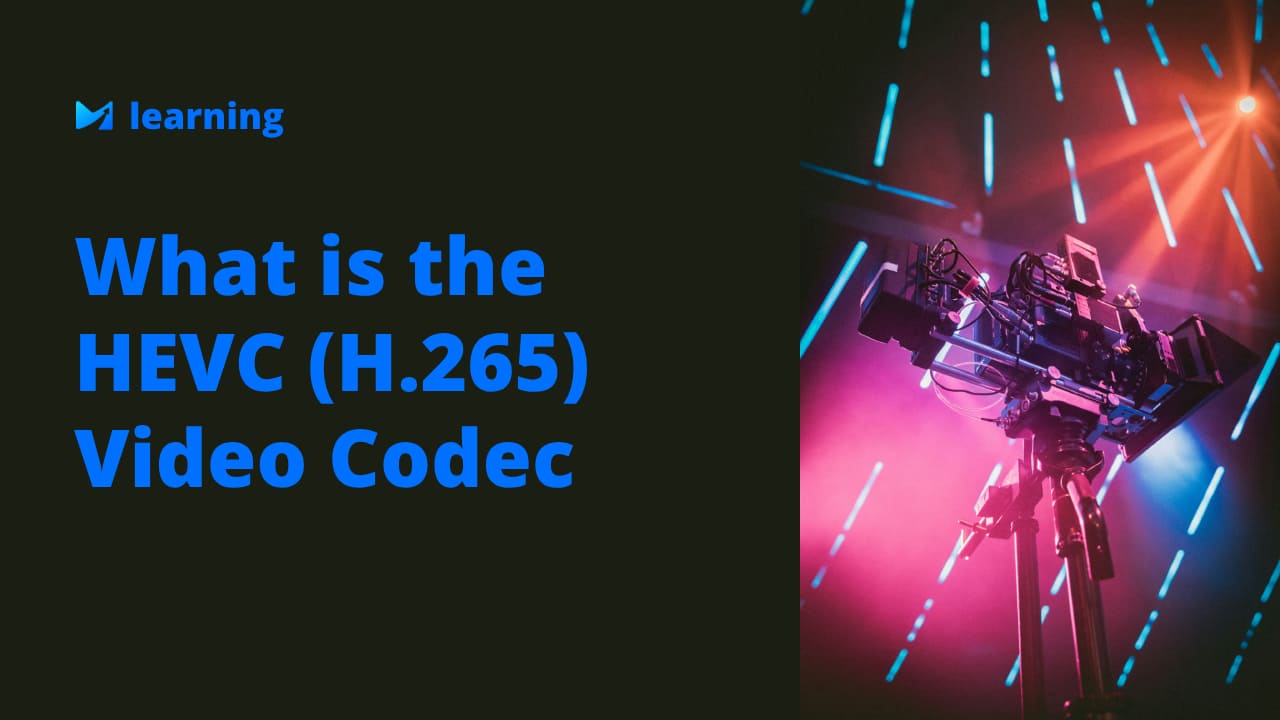Why H.265 (HEVC) is Revolutionizing Video Streaming
In the realm of digital video, encoding is a crucial process that determines the efficiency of video storage, transmission, and playback. Among the modern video codecs, the H.265 codec, also known as High Efficiency Video Coding (HEVC), stands out due to its superior compression capabilities and high-quality video output. This article dives deep into understanding the H.265 codec, its importance, benefits, use cases, and the advantages offered by Tencent MPS in leveraging this advanced technology.

What is Video Encoding?
Video encoding is the process of converting video files into a digital format suitable for various applications, such as streaming, storage, or playback on different devices. The primary goal of video encoding is to compress the video data without significantly compromising the quality, making it easier to handle, transmit, and store.
Several video codecs have been developed over the years, each with different levels of compression and quality. Some of the common codecs include H.264 (also known as AVC) and H.265 (HEVC). While H.264 has been widely adopted and remains popular, the H.265 codec is rapidly gaining traction due to its impressive capabilities.
Why is H.265 Codec Important?
The H.265 codec represents a significant leap forward in video encoding technology. Developed by the Joint Collaborative Team on Video Coding (JCT-VC), H.265 is designed to replace the older H.264 codec by providing improved compression efficiency and enhanced video quality.
The importance of the H.265 codec can be highlighted by comparing it with its predecessor, H.264:
Higher Efficiency: H.265 codec offers double the compression efficiency of H.264. This means it can reduce the file size of videos by up to 50% while maintaining the same level of quality. This higher efficiency is crucial for streaming high-definition content over limited bandwidth and storing large volumes of video data.
Support for Higher Resolutions: The H.265 codec is optimized for modern video resolutions, including 4K and 8K. With more consumers and content providers adopting high-definition displays, the ability to compress such large video files efficiently is essential.
Enhanced Quality: Despite its high compression rates, the H.265 codec manages to preserve video quality. This is achieved through advanced techniques such as improved motion compensation and prediction algorithms.
Benefits of Using H.265 Video Encoding
Adopting the H.265 codec for video encoding brings several benefits, especially for industries that rely heavily on video content. Here are some of the main advantages:
Bandwidth Savings
The H.265 codec’s superior compression capabilities translate into significant bandwidth savings. For streaming services, this means that videos can be delivered smoothly over slower internet connections, reducing buffering and improving the user experience. Lower bandwidth usage also translates to cost savings for content delivery networks.
Storage Efficiency
By reducing file sizes without compromising quality, the H.265 codec helps in optimizing storage requirements. This is particularly beneficial for cloud storage solutions and video archives where space can be a limiting factor.
Support for 4K and 8K Content
As 4K and 8K content become more prevalent, the need for a codec that can efficiently handle these high resolutions becomes critical. The H.265 codec is specifically designed to cater to these needs, making it ideal for ultra-high-definition content.
Improved Video Quality
The advanced algorithms used in the H.265 codec ensure that video quality is preserved even at lower bitrates. This results in a better viewing experience, with clearer and sharper images.
Versatility and Compatibility
The H.265 codec is versatile and compatible with various devices and platforms, making it a flexible choice for different applications, such as broadcasting, streaming, and video conferencing.

Use Cases of H.265 Video Encoding
Several industries have adopted the H.265 codec to enhance their video delivery and storage capabilities. Here are some prominent use cases:
Video Streaming Platforms
Major streaming services like Netflix, Amazon Prime Video, and YouTube have begun using the H.265 codec to deliver high-quality content efficiently. By leveraging H.265, these platforms ensure smooth streaming experiences for their users, even with high-definition and ultra-high-definition content.
Online Education Platforms
Platforms such as Coursera, Udacity, and edX use video extensively for delivering educational content. The H.265 codec allows these platforms to provide high-quality video lectures while minimizing bandwidth usage, ensuring that students with varying internet speeds can access the content seamlessly.
Live Streaming Sports Events
Sports broadcasters and streaming services like ESPN+, DAZN, and NBC Sports use the H.265 codec to deliver live sports events in high definition. The reduced bandwidth requirements and improved video quality ensure that viewers have an optimal viewing experience, even during fast-paced action.
Broadcast and OTT Platforms
Traditional broadcast networks and over-the-top (OTT) services, including Hulu, Sling TV, and Disney+, use the H.265 codec to enhance their video delivery. This allows them to provide high-quality streams to a broad audience without overloading their networks.
E-commerce Video Showcases
E-commerce platforms like Amazon, Alibaba, and eBay often use videos to showcase products. Using the H.265 codec helps these platforms present high-quality videos while ensuring efficient data usage and faster load times.
Gaming Video Streams
Gaming platforms and streaming services like Twitch and YouTube Gaming benefit from the H.265 codec's ability to deliver high-bitrate streams with minimal latency. This enhances the viewing experience for fans watching live game streams, highlights, and replays.
When to Consider Using H.265
Deciding when to use the H.265 codec depends on several factors, including the specific requirements of your video content and the constraints of your delivery network. Here are some scenarios where using H.265 makes sense:
Limited Bandwidth
If you are dealing with limited bandwidth, such as in remote or rural areas, the H.265 codec can help you deliver high-quality video without excessive data consumption.
High-Quality Video Needs
When high-definition or ultra-high-definition content is needed, such as in broadcasting sports or movies, H.265 is the ideal codec due to its efficiency in handling 4K and 8K videos.
Storage Constraints
For applications where storage space is at a premium, such as archiving large volumes of video data, H.265 provides an efficient way to reduce file sizes without sacrificing quality.
Real-Time Streaming
In scenarios requiring real-time streaming, such as live events or video conferencing, the low latency and high efficiency of the H.265 codec can enhance the overall experience.
Tencent MPS Advantages in Video Encoding
Tencent MPS leverages the H.265 codec to provide a range of advanced video encoding and processing solutions. Here are some of the key advantages offered by Tencent MPS:
High Efficiency Encoding
Tencent MPS utilizes a proprietary encoding core that can save over 50% bitrates without compromising video quality. This results in significant bandwidth savings and improved streaming performance.
Top-tier Video Quality Enhancement
By supporting real-time UHD transcoding capabilities, including 8K and 144FPS, Tencent MPS delivers superior audio-visual experiences. This is particularly beneficial for industries that demand high-quality content, such as broadcasting and sports.
Low Latency Transmission
With cross-continental transmission latency of less than 400ms and stable transmission capabilities even with 60% packet loss, Tencent MPS ensures smooth and reliable video delivery.
Comprehensive Media Solutions
Tencent MPS offers end-to-end media processing services, including encoding, enhancement, streaming, and playback. This comprehensive suite of tools allows clients to optimize their media workflows and improve the overall quality of their video content.
Industry Recognition
Tencent MPS has been a three-year consecutive winner of the MSU Video Codecs Comparisons and top-rated in all categories of encoding tests at the Streaming Learning Center Evaluations. This recognition underscores Tencent MPS's commitment to excellence in video encoding and processing.
Customized Solutions for Various Industries
Tencent MPS provides tailored media processing solutions for various industries, including education, entertainment, e-commerce, and gaming. This flexibility ensures that clients can leverage the H.265 codec to meet their specific needs.
Conclusion
The H.265 codec, also known as HEVC, represents a significant advancement in video encoding technology. Its benefits, including higher efficiency, support for higher resolutions, and improved video quality, make it an essential tool for modern video applications. Industries ranging from streaming services to online education and live sports have adopted H.265 to enhance their video delivery.
FAQS
Q1: What is the main difference between H.264 and H.265 codecs?
A1: The primary difference between H.264 and H.265 (HEVC) codecs is their compression efficiency. H.265 codec offers up to twice the compression efficiency of H.264, meaning it can achieve the same quality at half the bitrate, or higher quality at the same bitrate. Additionally, H.265 supports higher resolutions, including 4K and 8K, making it more suitable for modern, high-definition content.
Q2: Are there any compatibility issues with using the H.265 codec?
A2: While H.265 (HEVC) offers superior compression and quality, its adoption has been slower due to licensing costs and hardware support requirements. However, most modern devices, including smart TVs, streaming boxes, and recent-generation smartphones, support H.265. Software players like VLC and platforms such as YouTube also support H.265 playback. It's important to check device compatibility if you plan to distribute H.265 video widely.
Q3: How does H.265 codec affect streaming latency?
A3: H.265 can actually help reduce streaming latency by providing more efficient compression, which requires less bandwidth and enables faster data transfer. Additionally, Tencent MPS's low-latency transmission technology further optimizes live streaming and real-time video delivery, ensuring a smooth and immediate viewing experience even at high resolutions.
You are welcome to Contact Us for more information.

